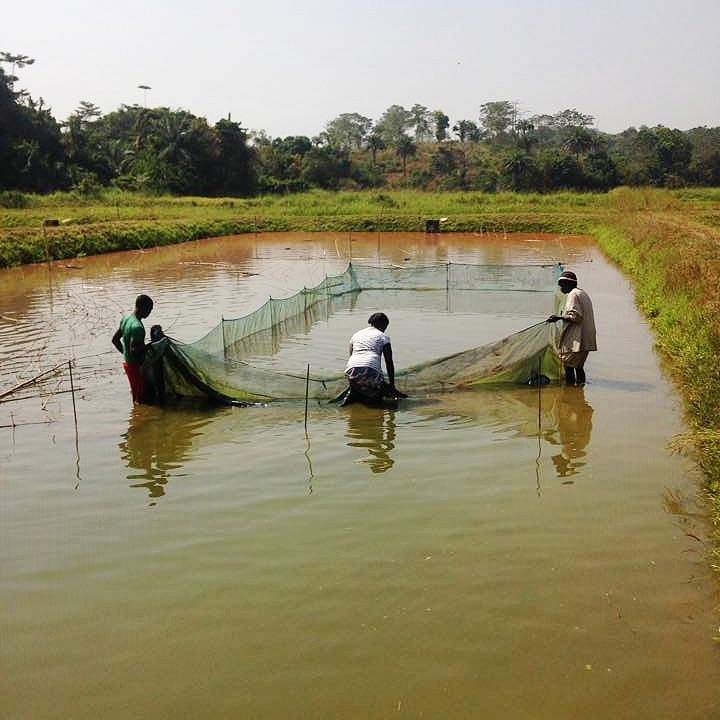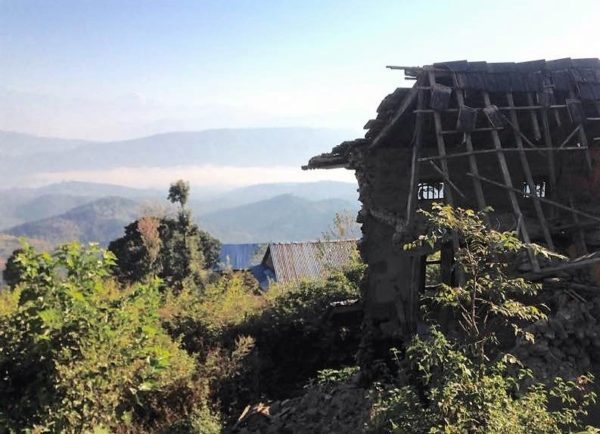In the steeps hills of Nepal, visitors soon notice that there are few men to be seen. Many have migrated for work: according to the Department of Foreign Employment, in 2014/15 men accounted for 95% of the estimated 500,000 permits issued to labor migrants in Nepal. In men’s absence, rural women have taken on the farming, working their lands, hand tilling narrow fields and relying on the cooperation of other women to be able to keep up with time-consuming agricultural tasks. The Ministry of Agricultural Development is supporting the dissemination of small-scale machinery, like powered mini-tillers, to support farmers – but will women use them?
In Sierra Leone women fish farmers collect the ingredients for fish feed, mold the mixture into balls, and toss them into ponds. They’re feeding tilapia, a fish integral to their livelihoods, with a new fish feed formulation introduced by World Fish. The women are responsible for daily care of the fish, but they have limited control over how land or resources are used; easier access to fish feed could open economic opportunities
These new technologies in Nepal and Sierra Leone aim to increase agricultural productivity and hopefully incomes, but to understand their ripple effects on men’s and women’s lives we must look deeper. Do both men and women have access to these technologies? How do women farmers benefit from them? Do the technologies allow both men and women to increase their income?
As part of the Integrating Gender and Nutrition within Agricultural Extension Services (INGENAES) project, Cultural Practice, LLC (CP) led the development of a methodology to explore the relationship between agricultural technologies and gender issues as a means of understanding the potentially different ways that men and women benefit from them. The methodology is intended to help agricultural researchers and practitioners identify men’s and women’s agricultural activities, their different needs and preferences, and what those differences mean for the design and dissemination of technology.

Photo Credit: Caitlin Nordehn.
The Need for the Toolkit
While much has been written about how agricultural technologies can impact women’s lives, for example by reducing time-intensive chores, there are few guides that help researchers and practitioners analyze the potential impacts of agricultural technologies on men and women. This type of analysis is often reserved for gender specialists. The INGENAES technology assessment toolkit will change this. The toolkit outlines a process for understanding how agricultural technologies can be designed and disseminated to reach both men and women farmers with the ultimate aim of ensuring that all farmers can improve their productivity and benefit from agricultural investments.
Technological solutions get a lot of attention. The benefits of improved seeds, mechanized equipment, and customized fertilizer blends are touted as being necessary to solve today’s complex agricultural challenges. And they are, but they are not sufficient. As Cristina Manfre and Caitlin Nordehn explained during a webinar on assessing agricultural technology, the focus on the technological solution often overshadows an understanding of the needs of the men and women farmers who are meant to adopt and benefit from these solutions. Many of these technological products don’t respond to women’s specific challenges, are priced too high, or are unavailable to them. The INGENAES technology assessment methodology is designed to draw the focus of agricultural technologies back onto men and women farmers.
Social context matters. Agricultural technologies do not exist in isolation and the methodology builds on a framework that connects social norms, behaviors, and gender relations to agricultural outcomes like productivity and income generation. The methodology is designed to unearth how agricultural technologies have the potential to change food availability, quality, and safety; time and labor; and income, and understand the potential consequences of these changes on men’s and women’s lives. Binta Jalloh, the local INGENAES coordinator in Sierra Leone, said, “Sometimes the women work more than the men…but women don’t have decision making [power].” Could a new technology impact who controls decision-making?
How the Toolkit Came to Be
The development of the INGENAES technology assessment toolkit has been a multi-year effort to design and test the methodology. The process began in 2015 with the development of an initial framing of the methodology and a set of data collection tools that were applied to seven agricultural technologies in Bangladesh and Zambia. The data collection was conducted by a group of undergraduate and graduate students from the University of Illinois Urbana-Champaign, University of California, Davis, and the University of Florida who with the support of Cultural Practice conducted the analysis and finalized the technology profiles. Following this initial effort, Cultural Practice refined the methodology which was used to analyze additional technologies in Nepal and Sierra Leone.
CP also developed a set of capacity building materials to train agricultural researchers and development practitioners on the methodology. This was piloted in Bangladesh in collaboration with the Bangladesh Agricultural University, and replicated with agricultural researchers, students and practitioners from the Master in International Cooperation and Development (MICD) program in Nepal, Njala University in Sierra Leone, and the University of Illinois Urbana-Champaign.
Moving Forward
Sumana Parui, a consultant working with CIMMYT in Nepal, commented that the issues raised by the assessment are a “stepping stone for studying the involvement of women with technology…not only in the rural hilly areas of Nepal but also in other developing countries like Nepal.”
The forthcoming toolkit will be useful to researchers and practitioners interested in learning how to enhance the value of agricultural technologies to contribute to higher incomes and healthier outcomes for men and women farmers. It will compile the learning from the pilot into a three-part guide, available in Fall of 2017. The three parts – Learn, Apply, Share – will provide knowledge on key issues, introduce a gender analysis framework and a range of tools, and provide a facilitator’s guide for designing and delivering a workshop.
Sign up for our newsletter and follow us on Twitter or Facebook to be the first to know when the toolkit goes live in Fall of 2017!
Featured Photo: Landscape in Nepal. Credit: Caitlin Nordehn.

